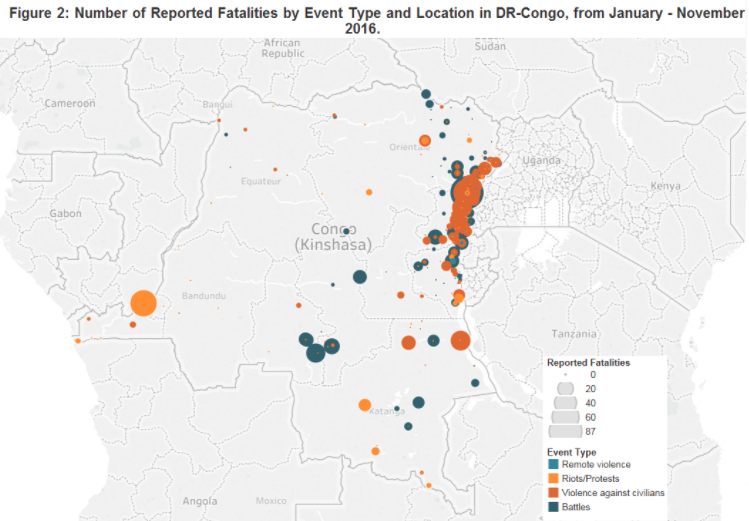One could be forgiven for thinking the Congo is on the brink of another military escalation. Rumors of Rwandan and Ugandan intervention have been smoldering for weeks now, and recent outbreaks of violence in the Kivus, Kasais, and Tanganyika provinces have killed hundreds in recent months. The United Nations says that in the last six months, 300,000 were displaced in the Kasaias and Tanganyika alone, bringing the total in the country to over 2,2 million.

There are at least five simultaneous dynamics taking place:
- Fighting between militias in southern Lubero and northern Rutshuru territories of North Kivu is drawing on long-standing tensions between the Nande and Hutu communities over political power, land tenure, and customary rule. These tensions erupted following a renewed push by the Congolese army, backed by the UN peacekeeping mission, to crack down on the FDLR last year. The Sokola II operations used local proxies from the Nyanga (NDC-R) and Kobo/Nande communities (UPDI/Mai-Mai Mazembe), which then led to a counter-mobilization by Nyatura militias from the Hutu community. Local and national politicians have––at the very least at the level of rhetoric––become involved.
- The M23 have made a comeback, stirring out of a three year slumber, making incursions into Ruthuru territory. On January 15, North Kivu Governor Julien Paluku warned that M23 leader Sultani Makenga, who has been living under Ugandan supervision in Kampala since November 2013, was preparing an attack. While Paluku has been wrong before, this time he appears to have been well-informed, as on 27 January the Congolese army sent two attack helicopters to hunt down the rebels in the Virunga national park. (The aircraft crashed––either felled by the M23 or downed by bad weather.) Several days later, Ugandan authorities announced that they had arrested 101 M23 fighters on their way to the Congo. Since then, there have been numerous clashes between M23 and FARDC around the town of Rutshuru and toward Bwiza, on the border with Masisi territory. While it is now clear that the M23 are back in business, it is unclear what Uganda’s role is. Both countries have arrested dozens of them in recent months––but how did Makenga and the M23 soldiers slip out of their Ugandan safe houses and army camps in the first place? It is true that most of the 1,300 rebels who crossed into Uganda in 2013 had auto-demobilized, leaving their army camps to return home. But that does not explain how senior officers like Makenga and Yusuf Mboneza, who is also rumored to be back in the Congo, could have slipped out.
- The situation in the Grand Nord––the northern part of North Kivu––has also seen an escalation. Not only have massacres continued around the town of Beni––21 civilians were killed on December 24, for example––but militias have begun to appear around the town of Butembo, as well. The Corps de Christ armed group emerged out of a Christian sect founded in 2007 and was eventually militarized by a preacher called David Maranata. The sect was based just outside of Goma and appears to have merged with local Mai-Mai militia leaders, including Saperita and Baraka, possibly with the backing of politicians. In January, Bwambale Kakolele, a veteran military entrepreneur from Butembo who until recently had been in Kinshasa, proclaimed himself the leader of the militia. Maranata was arrested in early February but Kakolele remains at large.
- In the central Kasai provinces, a local conflict over customary power spiraled out of control in the latter part of 2016 after the death of a local chief. His son, Jean-Pierre Pandi, was allegedly installed by the customary elders, but the government refused to recognize him. In response, he created a militia, prompting a heavy-handed clampdown by the FARDC. In August 2016 they killed Pandi, also known as Kamuina Nsapu, provoking an escalation of violence throughout the region as resentments against the government have spread. (Listen to the CRG podcast on Kamuina Nsapu here).
- In Tanganyika province, there have been renewed bouts of violence between the Batwa (pygmy) and Luba communities. Tensions between the two communities erupted in mid-2013 in Manono territory, after Batwa started denouncing systematic discrimination against their community. Both communities have formed loosely organized militias and the fighting has taken place in Kabalo, Kalemie, and Nyunzu territories. According to the UN, some of the worst displacement in 2016 took place due to this conflict. A government delegation, led by the minister of interior, visited the area to promote reconciliation this past week.
And I have not even mentioned the Bundu dia Mayala conflagration in Kinshasa, or the conflict between Babuyu and Banyamulenge in Fizi territory (South Kivu).
What is behind all of this? Are there any connections or sinister hands pulling strings? There is no evidence of that, and it beggars belief that anyone would be able to pull together such disparate armed groups. It is more likely that happenstance has collided with opportunism as various actors––armed groups, politicians, possibly neighboring governments––sense a weak central government and are trying to bolster their hand as the country traverses a transitional period.
